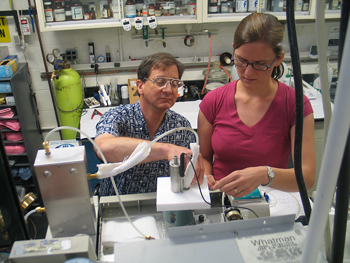Chemists from the National Institute of Standards and Technology in the USA (NIST) succeeded in demonstrating a relatively simple and inexpensive method for detecting and measuring dangerous substances such as explosives and poisons removed and more

Chemists from the US National Institute of Standards and Technology (NIST) succeeded in demonstrating a relatively simple and inexpensive method for detecting and measuring dangerous substances such as explosives and detonated toxins, spoiled components in food or pesticide residues that were dispersed in the soil by wind or rain.
The new method is more sensitive than other existing methods for the detection of traces of polar substances which, like water, have a defined negative electric end and positive electric end, and which do not evaporate easily.
As described in the new article, the institute's researcher Tom Bruno was able to increase the method known as "head space analysis" which is used to locate and test the residual levels of chemical compounds from a solid or liquid that are released into the surrounding air. The new method greatly increases the efficiency of sample collection and for the first time allows the method to be adapted to detect the smallest concentrations of polar substances with low volatility, such as explosives. Preliminary findings indicate that the method is sensitive enough to measure quantities of substances present in a concentration of only 0.0000002 percent of the sample.
The sample collection device consists of several cylinders with thin tubes whose inner thickness is only 0.32 millimeters. The researcher changed the inner coating, which is responsible for attracting or repelling substances through its high surface area. The new facility can be used with an oven for heating samples found in laboratories that perform analyzes or taken to the field to collect samples. In order to attract target compounds from the sample, the coil is placed inside an insulated cylinder cooled by a stream of cold air to a temperature of minus forty degrees Celsius. A carrier gas, such as helium, is injected into the interior of the sample in the oven or coil fixture, collecting the target compounds and bringing them into the tiny tubes. Cooling the coils - part of the researcher's invention - improves the efficiency of collecting the compounds. The tubes are washed with solvent, or heated, to release the compounds trapped in them for the test.
The researchers found that the amount of compounds collected increases depending on the heating temperatures and the carrier gas, while obtaining a means to identify unique target compounds in field conditions. The researchers demonstrated their innovative method using several explosives, including the standard explosive TNT and the plastic explosive C-4. Among other applications, the researchers used their method to improve the collection and diagnosis of vehicle exhaust gases, an issue of utmost importance for public safety and the quality of the environment. In addition, they use their method to detect volatile breakdown products of proteins in spoiled meat products. Environmental applications include the detection of pesticides that have accumulated in the soil and may be dispersed in changing weather conditions.

2 תגובות
To Michael.
right. my mistake Thanks.
The literal translation of headspace is "the space of the front" and not "the front of the space"